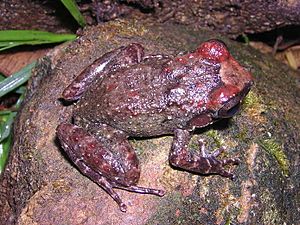Eleutherodactylus turquinensis facts for kids
Quick facts for kids Eleutherodactylus turquinensis |
|
|---|---|
 |
|
| Conservation status | |
| Scientific classification |
Eleutherodactylus turquinensis is a special kind of frog that lives only in Cuba. It's often called the Turquinense Rain Frog. This small frog belongs to a family of frogs known as Eleutherodactylidae. These frogs are unique because their babies hatch directly from eggs as tiny froglets, skipping the tadpole stage!
Contents
The Turquinense Rain Frog
The Eleutherodactylus turquinensis is a fascinating amphibian. It was first described by scientists Barbour and Shreve in 1937. This frog is part of a very large group of frogs found mostly in the Americas. Many species in this group are known as "rain frogs" or "direct-developing frogs."
What Makes Rain Frogs Special?
Most frogs lay their eggs in water, and the eggs hatch into tadpoles. These tadpoles then live in the water, slowly changing into adult frogs. But rain frogs like the Eleutherodactylus turquinensis are different. They lay their eggs on land, often in damp places. Instead of tadpoles, tiny froglets hatch directly from the eggs. This special way of developing helps them live in places without permanent ponds or streams.
Where Does It Live?
The Turquinense Rain Frog is endemic to Cuba. This means it is found naturally nowhere else in the world. Its home is in the forests of Cuba, especially in the mountains. It likes places that are moist and warm.
- Lowland Forests: These are forests found in lower areas, often near the coast. They are usually very humid.
- Montane Forests: These forests are found in mountainous regions. They are also moist, often with clouds and mist.
- Near Rivers: Even though they don't need water for tadpoles, these frogs still prefer to live close to rivers. This helps keep their surroundings damp.
Why Is It Endangered?
Sadly, the Eleutherodactylus turquinensis is a critically endangered species. This means it faces a very high risk of disappearing forever. The biggest threat to this frog is habitat loss.
- Forest Clearing: Forests where these frogs live are being cut down. This happens for farming, building homes, or other human activities. When their forest home is gone, the frogs have nowhere to live or find food.
- Climate Change: Changes in weather patterns can also affect their habitat. If an area becomes too dry, it might not be suitable for these moisture-loving frogs.
- Pollution: Pollution from human activities can harm the water and soil, making it difficult for frogs to survive.
Protecting the Turquinense Rain Frog
Protecting endangered species like the Turquinense Rain Frog is very important. Scientists and conservation groups are working to save their habitats. This includes setting up protected areas where forests cannot be cut down. Learning more about these unique frogs also helps us understand how to protect them better. Every species plays a role in its ecosystem, and losing even one can affect many others.
See also
 In Spanish: Eleutherodactylus turquinensis para niños
In Spanish: Eleutherodactylus turquinensis para niños


